

International
Labour Organization
Your health and safety at work
USING HEALTH AND SAFETY COMMITTEES AT WORK
Negotiation is not a discussion — it is a collective bargaining session between workers and management. It is through the collective bargaining process that many changes in the workplace can be made. Since negotiation is a bargaining session, a local health and safety committee or health and safety representative should be prepared to compromise on some issues.
As a health and safety representative (the person who will be negotiating with management), you may not have a lot of training or experience in negotiating before having to bargain for the first time with the management and therefore may not feel very confident. However, there are some basic points which, if followed before meeting with the management, will help to prepare you and build your confidence.
Learn what your legal rights are. Once you know your rights, you will be in a better position to negotiate specific health and safety problems with the management.
Study the law and determine what rights you have. Make a poster for the workplace and union hall. |
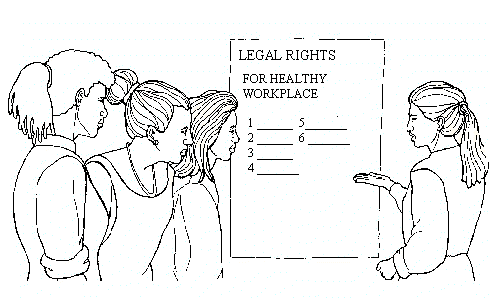 |
Prepare the case
This cannot be stressed strongly enough. You must be clear about what you want from any meeting or negotiation with the management.
If you need to, talk to a more experienced union representative to get advice.
Summarize your legal rights and make a booklet to distribute to all workers |
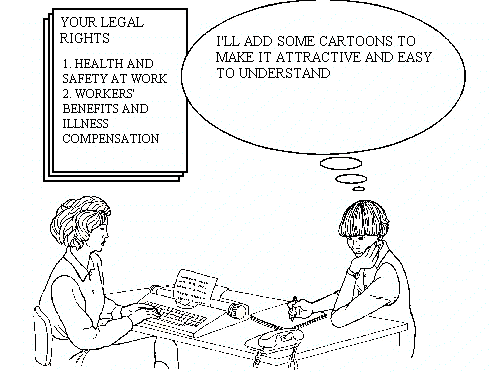 |
The negotiation
If your workplace does not have a basic health and safety agreement, then it is important to hold negotiations to establish one. It may also be necessary to hold negotiations on specific cases as they arise, such as cases concerning:
Begin your negotiation with items that are easiest to achieve. For example, as a first step it may be easier to get all chemicals labelled properly than to get rid of very dangerous ones. |
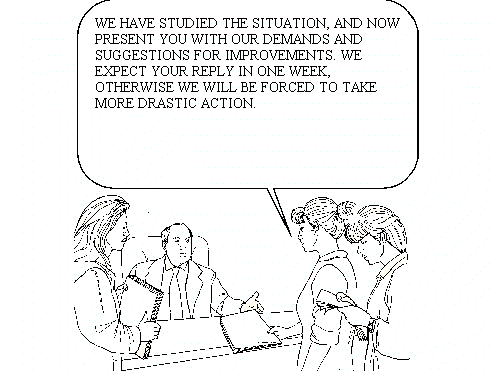 |
Arguments and strategies on chemical hazards
Incorrect arguments
Chemicals are innocent until proven guilty. Workers should prove that a chemical or work process is dangerous.
The generic names of chemicals are trade secrets.
The costs of health and safety measures outweigh the benefits.
Strategies to avoid
Correct arguments
Chemicals are guilty until proven innocent. Managers, government inspectors and medical doctors should prove that a chemical or work process is safe and healthy.
For medical reasons, workers and the doctors of their choice have the right to know at all times the generic names and ingredients of all chemicals to which they are exposed, whether the worker is ill or not, and whether the chemical is deemed “safe” or not.
The lives, safety and health of every person at work are not negotiable and cannot be compromised, whatever the costs.
Strategies to use
By showing evidence it may be easier to convince management that a chemical or work process is dangerous and that there are ways to make it less hazardous. |
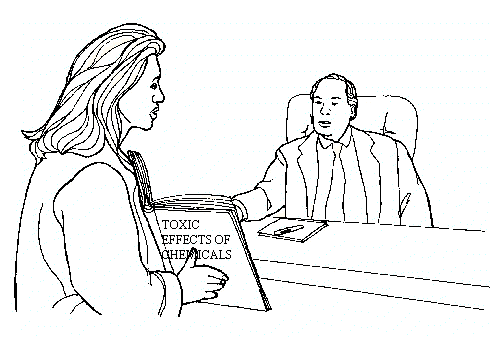 |
Remember: Negotiation is an ongoing process and should be highlighted by study and monitoring of working conditions.
Good negotiators spend less time negotiating with the management and more time learning about the problems of workers. One of management's best tactics is to provide much time for talking, giving the impression of sincerity. |
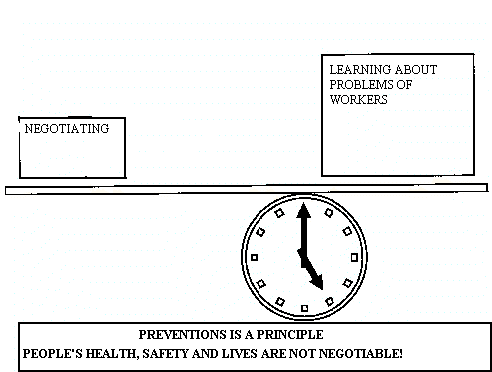 |
H. Evaluating your committee's effectiveness
It is a good idea to assess the effectiveness of your health and safety committee periodically. Getting feedback from co-workers from time to time will help the committee to improve its activities and methods of functioning. The committee can get feedback from workers in a number of ways, such as through group discussion in a training course, by written evaluation, or from informal conversations with workers. The following are some suggested criteria you can use to assess your committee's effectiveness. You may want to add other criteria of your own.
Level of management support. Without the support of management, it is very difficult for a health and safety committee to make effective and positive changes in the workplace. Therefore, assess whether the management fully supports the committee. Does the management provide information when it is requested? Do they provide educational leave and meeting facilities for the committee members to carry out their duties? Do they provide adequate training for workers? Do they respond in a timely manner to make changes where indicated?
Responding to problems. It is important for a health and safety committee to respond to and resolve problems in a timely manner, particularly serious problems (i.e. situations at work which threaten life or health, as well as other high priority issues). Does your committee put problems into priority order and respond to them quickly?
Worker confidence in the committee. It is important that workers on the shop-floor have confidence in the committee and believe that it is useful and effective in responding to their needs. It is up to the health and safety committee to build this confidence so that workers will support the committee's activities and provide continuous feedback on conditions in the workplace. Do the workers on the shop-floor feel that your committee is useful?
Availability of records. Records of the health and safety committee's activities should be available to all workers. These records should include minutes of committee meetings, the committee's recommendations, actions they have taken and reasons they have for not implementing recommendations. Are all records available to the workers? How does the committee let workers know that these records are available to them?
The following is a sample questionnaire you can use to get confidential feedback from workers about the committee.
Sample questionnaire for evaluating the effectiveness of a health and safety committee
Does management support the efforts of the committee? Do they provide information when it is requested? Do they provide paid educational leave, meeting facilities and training for the committee members and respond in a timely manner to requests for changes? ......................................................................................................................................... ......................................................................................................................................... ......................................................................................................................................... .........................................................................................................................................
Does the committee put problems into priority order and respond to problems quickly? ........................................................................................................................................ ........................................................................................................................................ ......................................................................................................................................... ........................................................................................................................................
Do workers believe the committee is useful and effective in responding to their needs? ........................................................................................................................................ ........................................................................................................................................ .......................................................................................................................................... ..........................................................................................................................................
Are all records of the committee made available to the workers?
....................................................................................................................................... ....................................................................................................................................... ....................................................................................................................................... .......................................................................................................................................
It is a good idea to carry out health and safety inspections on a regular basis, with the responsible supervisor, production manager, health and safety representative, trade union representative and the health and safety committee taking part. Look for risks that may occur when new chemicals, machines or equipment are introduced, besides checking that measures have been taken in accordance with previous decisions. |
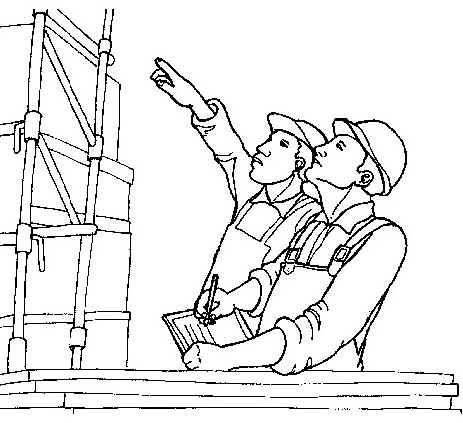 |
Look at your workplace
Hazards are not always obvious and even when they are, workers often become accustomed to them if they have existed for a long time. Regular workplace inspections make everyone more aware of obvious hazards. They are also the best way to find less obvious hazards.
In some workplaces, members of the health and safety committee perform regular inspections. In others, a health and safety representative conducts the inspection and reports back to the committee. Some employers will agree informally to let union members make regular inspections while in other places workers will have to win the right to conduct inspections.
Special inspectors often need to carry out annual inspections of transport vehicles, cranes, pressurized vessels, etc. The supervisor responsible and the operator should also carry out their own inspections of equipment. To improve safety, daily inspections should be carried out by the operator when starting up the machines. |
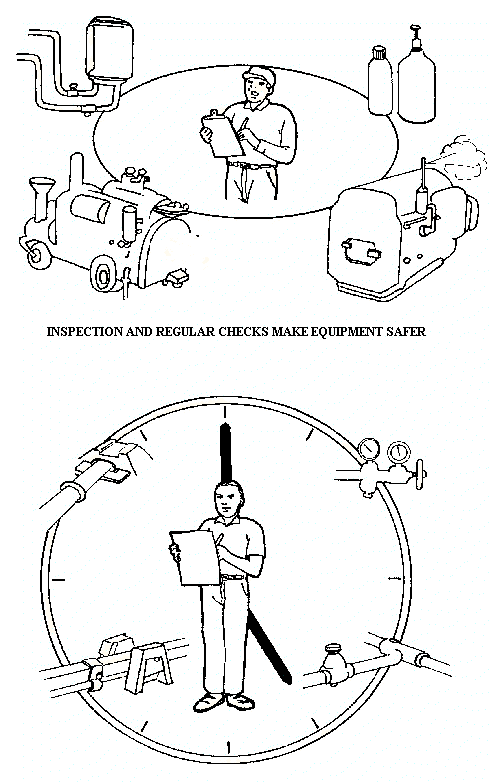 |
The following are some suggestions for conducting worksite inspections for health and safety hazards:
Talk to workers during the inspection. They may be aware of hazards in their immediate area that you would not otherwise notice.
Keep the results in writing. This allows the union to keep track of hazards that have been identified as well as action that has or has not been taken.
Make diagrams showing the location, type, etc. of hazards you find. For example, you might mark an area where you heard loud noise, where there was an uncovered hole in the floor, or where you smelled chemical vapours. Write down the number of workers who are affected and whether they have ever complained to the employer. Put reminders on the diagram if you need to get more information about a hazard that you observed. These diagrams are useful in health and safety committee meetings, union discussions, meetings with management or government inspectors. Be sure to put the date on the diagrams indicating when you did the inspection.
Perform an accurate inspection. If you do not have enough time to perform the inspection properly, it may be better to do a complete inspection of one area of the workplace at a time. Alternatively, you may want to inspect the entire workplace but only look for certain problems.
It is impossible to remember everything that has to be checked during a workplace inspection. Therefore, you may want to use the General checklist for workplace inspections at the back of this Module to help you identify potential hazards during the workplace tour. After inspecting your workplace and talking to workers, you may want to develop your own list, making it specific to your workplace.
Use written health surveys
Health and safety committees should investigate all accidents in order to suggest ways to prevent them in the future. They should also investigate “near-accidents” or “near-misses”, as they are sometimes called. Even if no one is hurt, there may be unsafe conditions that should be corrected.
It is important to investigate an accident or near-miss soon after it happens while all evidence is still available and events are fresh in everyone's memory. Whenever possible, the health and safety committee investigator should make a diagram of the area where the accident occurred. It is important to interview all witnesses, note their names, describe the equipment or any substances involved, the exact location and the general conditions (such as lighting, noise, etc.) at the time of the accident. List the exact sequence of events, noting who was involved and when. If the injured worker has been hospitalized, you may need to interview him or her in the hospital. However, if a serious accident has occurred, it is important to remember that any victims/witnesses may be in shock and therefore may be uncertain of what they are saying.
If the injury is serious, you will almost certainly have to call in the appropriate local or national agency to perform an inspection. Whatever the eventual outcome of any investigations, it is important to let other workers know the results by word of mouth and through leaflets or notices on bulletin boards.
In the separate booklet in this collection entitled Using health and safety committees at work. Appendices, are sample forms which you may find useful: Appendix V is a sample workplace health survey; Appendix VI is a sample report for an accident or near-miss investigation; and Appendix VII is a sample employee report of an injury.
Suggested measures should be formulated in a way that can be accepted by the staff involved. Issue information on the results of safety inspection rounds and proposed measures. It may be necessary for purchase officers, maintenance staff, training officers, etc. to be aware of the measures that have been introduced in order to make them as effective, practical and economical as possible. |
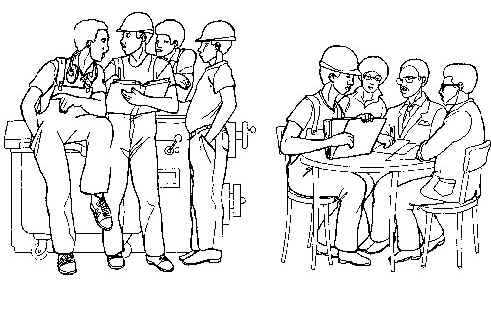 |
Investigate illnesses
Many health hazards are never corrected because workers do not realize that their illnesses or health problems are work-related. If a worker becomes ill, you should explore the possibility that the illness is related to working conditions. Use the following questions to look for indications of work-related illness:
Is there information connecting the illness to a workplace hazard in books, factsheets, or other materials you can find? For example, an agricultural worker complains of throat, nose and lung irritation. Before assuming that the symptoms are caused by a cold or infection, identify the chemical composition of any agrochemicals the worker may be using and note any personal protective equipment he or she may be using. Then, using these Modules, hazard data sheets, chemical factsheets or other information you can find, determine whether any of these chemicals are known to cause cold-like symptoms. If they do, the health and safety committee, the union and the workers involved could ask the employer to substitute another agrochemical or provide adequate protection.
Are the health problems more severe during the work-week when the worker is exposed to suspected hazards? Do the problems get better at night, on weekends or during vacations?
Did the illness begin shortly after a worker was exposed to a new chemical or an unusually large amount of a chemical?
Are there other workers in the same job or department suffering from similar problems?
If there is a company doctor, have a significant number of workers visited him or her with similar complaints? Checking this with the company doctor can alert you to a potential work-related problem.
If the answer to any of these questions is yes, you should perform an investigation of the workplace.
 |
Points to remember about joint labour-management health and safety committees |
|
|
The following are some general comments about the advantages and disadvantages of committees that exist by legal mandate.
1. A minimum standard
It is important to remember that a committee established by legislation is an official recognition by the government of the legitimate rights of workers and their unions to be involved in solving health and safety problems on a day-to-day basis. Legislated committees should be seen as a starting point, that is, as a minimum standard for worker and union health and safety powers.
2. An advantage for unorganized workers
Workers who are not members of a trade union may be able to make their health and safety demands known through legislated committees. However, the extent to which they can use these committees will be limited because the workers are not in a union. Experience has shown that legislated committees can work in such circumstances, but that they are more effective where unions exist. It is not yet clear how significant these committees will be for unorganized workers.
1. Coverage
Not all workers will be protected by legislated committees and wide gaps may exist in many areas.
2. Duties and responsibilities
In general, legislated committees are only advisory. They have the power to recommend changes but with no guarantee that their recommendations will be implemented. Committee concerns that cannot be resolved at the committee level will inevitably become collective bargaining demands.
 |
Points to remember |
|
|
| V. Summary | |
 |
|
| Exercise. Worksite visit and health and safety committee role play | |
 |
Note to the instructor This exercise has two parts: the first part is a worksite visit and the second part is a role play. For the role play you will need a flipchart (or large pieces of paper taped to the wall) or a chalkboard and chalks. Trainees will need paper for taking notes. Approximately 1 hour and 30 minutes is recommended for the role play exercise, including the group work prior to the role play and the discussion following. The time needed for the worksite visit depends on whether you are looking at an entire workplace, a single work process, etc. It is not necessary for the role play to follow the worksite visit directly. Instructions The worksite visit and follow-up reports
The role play The next part of this exercise is a role play of a joint labour-management health and safety committee meeting. There is a description of role play in the Instructor's guide to the modules which includes some recommended rules to follow. Decide how much time you can allow for this part of the activity — approximately one hour is recommended for the role play and final discussion.
Trade union health and safety strategies
|
General check-list for workplace inspections
 |
The following check-list has been designed to help you carry out a workplace inspection. It is not intended to be exhaustive or cover all the problems a health and safety representative may come across. You will, however, get an idea of the sorts of questions that should be included when producing your own inspection check-list. |
Question |
Answer |
Action required |
|
Emergency exits |
|||
1. |
Are adequate safe exits and entrances provided? |
||
2. |
Are all emergency exits free from obstacles? |
||
Passageways |
|||
3. |
Are they clear of obstacles? |
||
Fire prevention |
|||
4. |
Are no smoking areas clearly marked? |
||
5. |
Are fire doors marked? |
||
6. |
Are fire alarms adequate? |
||
7. |
Are workers clear what to do in the event of a fire? |
||
8. |
Do they know the evacuation drill? |
||
9. |
How often is the drill practised? |
||
10. |
Are fire extinguishers or similar measures provided? |
||
11. |
When were they last checked? |
||
Housekeeping |
|||
12. |
Are the walls and ceiling in good condition? |
||
13. |
Are floors in good condition? |
||
14. |
Are they cleaned regularly? |
||
Machinery |
|||
15. |
Are all moving parts of machinery securely fenced? |
||
16. |
Are all fixed guards in good condition and securely fastened? |
||
17. |
Are all automatic guards properly adjusted? |
||
18. |
Are any safety switches in working order? |
||
19. |
When were they last checked? |
||
20. |
Are all emergency stop buttons labelled and working? |
||
21. |
Is all electrical equipment regularly checked? |
||
Storage and handling |
|||
22. |
Are storage facilities adequate? |
||
23. |
Is all racking and shelving in a safe condition? |
||
24. |
Have workers been trained in the handling of materials (e.g. lifting)? |
||
25. |
Is there adequate equipment for handling materials? |
||
26. |
Have safe procedures for the storage of materials been established? |
||
Dangerous substances |
|||
27. |
Are there any dangerous substances used? |
||
28. |
Have hazard data sheets been provided? |
||
29. |
Are workers trained in handling and using them? |
||
30. |
Is adequate information displayed on their presence? |
||
31. |
Are containers holding dangerous substances clearly marked? |
||
32. |
Are dangerous substances safely stored? |
||
33. |
Are there adequate extraction facilities for fumes or dust? |
||
Noise |
|||
34. |
Are noise risks assessed and danger areas identified? |
||
35. |
Is there a programme of noise reduction/control? |
||
Protective equipment |
|||
36. |
Is protective clothing necessary? |
||
37. |
Is it suitable? |
||
38. |
Is ear or eye protection necessary? |
||
39. |
Is it suitable? |
||
40. |
Are protective gloves necessary? |
||
41. |
Are they suitable? |
||
42. |
Are there any other hazards? |
||
Environmental conditions |
|||
43. |
Is the lighting adequate? |
||
44. |
Is the heating adequate? |
||
45. |
Is the ventilation adequate? |
||
46. |
Is the furniture (desks, chairs, etc.) suitable? |
||
47. |
Does anything else make the workplace uncomfortable? |
||
Training |
|||
48. |
Have all workers been trained in the safety aspects of their job? |
||
49. |
Have workers facing particular hazards received specialized training? |
||
50. |
How many workers have been trained in first aid? |
||
Welfare |
|||
51. |
Is there overcrowding? |
||
52. |
Are the washing and toilet facilities adequate? |
||
53. |
Are they kept clean? |
||
54. |
Are there changing facilities and a rest room? |
||
55. |
Is drinking water provided? |
||
56. |
Are there adequate first-aid facilities? |
||
Add your own points |
|||
57. |
|||
58. |
|||
59. |
|||
60. |
|||
61. |
|||
62. |
|||
63. |
|||
64. |
|||
65. |
|||